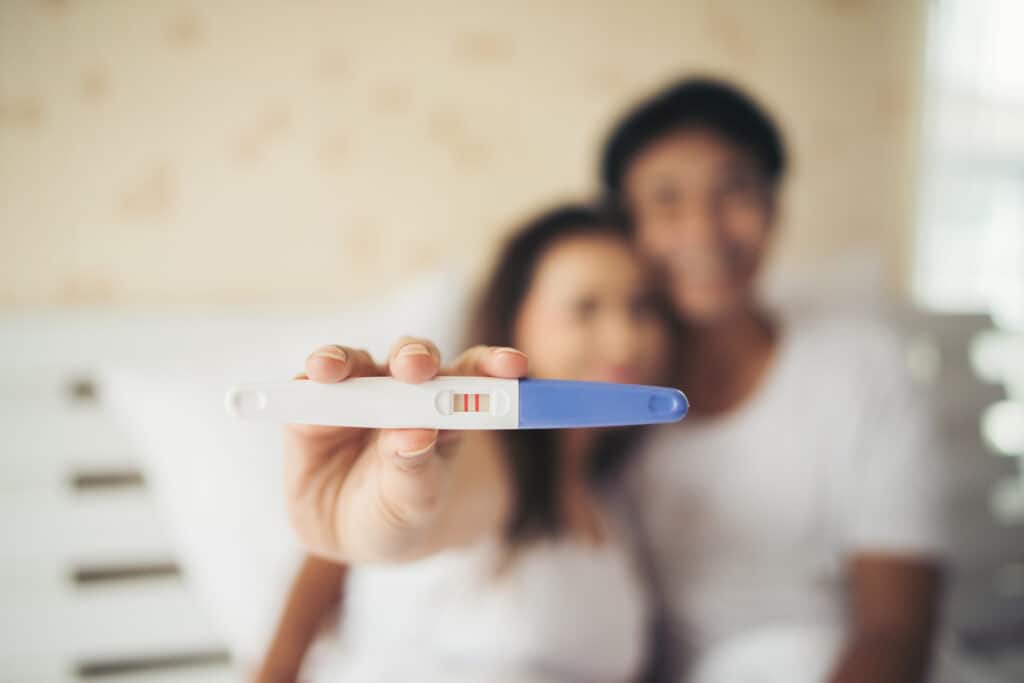Being pregnant for a woman means getting into a whole other stage of life. It is an exciting period but also a stressful one because it brings up an array of science and chemistry questions, the first being: how do pregnancy tests work?
Before we get into the Clearblue pregnancy testing kit, let’s talk a bit more about what you and your husband can expect when testing on the day of your expected period. Can you trust the results of such products with 100% certainty?
Pregnancy Tests History in the United States
Did you know that scientists developed the first products for testing pregnancies in the 1970s? Before that, the only way doctors could find if a woman were pregnant was through some unusual lab tests that involved female mice. However, for the relevancy of this review, we will not go deep into the history of pregnancy testing here.
First Response Symptoms
Some women can detect their pregnancy hormone levels rising from the early stages of fertilization even before they do a home test or visit their doctor to get blood work done. The first response symptoms manifest as a missed period, nausea and vomiting, or even feeling overly tired without any reason.
Pregnancy Tests Detection
Tests, either done before the first response signs or after, can determine with a claimed 99% accuracy if a woman’s pregnant or not. The most reliable results come a few days after you miss a period, with some being even more sensitive than that, stating that they can detect the hCG hormone as early as 8 days after conception.
The human chorionic gonadotropin (hCG) hormone is produced by the cells in the placenta. Soon after conception, it starts growing in the bloodstream, too, until it’s shown in the urine. 6 to 12 days after conception, the woman has enough quantities of this hormone to be detectable through any type of test.
To find out when they can conceive with the highest accuracy, some women take an ovulation test too, which determines their exact ovulation period. Then, when conception occurred, hCG appears and starts supporting the function of the corpus luteum.
The corpus luteum produces estrogen and progesterone, essential hormones that relax the muscular wall of the uterus and prepare the tissue lining so that the embryo can implant. These two are also in charge of developing the fetus, stimulating organ growth, and thickening the lining of the uterus.
Even though the hCG concentration level is the highest about 8 to 11 weeks after conception, a good urine test can detect pregnancy from the first day of your expected period.
The Testing Process

After conception, the hCG hormone is eliminated through the urine from the mother. This is why pregnancy tests are placed under the urine stream for best detection.
When the liquid reaches the reaction zone, this part checks for the hCG and releases the antibodies that attach to this hormone. These antibodies then move further along the test stripe all the way to the display with the indication lines.
The enzymes on the antibodies are now mixed with the urine, and as such, they trigger a color change in dye molecules on the test strip. If the second line appears, that means a certain level of hCG has been spotted. If not, then the antibodies pass through without coloring the display for a positive result.
In the United States and worldwide, recently digital pregnancy tests have become more common. Even though these look a bit different, on the inside, they work in the same way through hormone detection. The only difference is the display that writes ‘pregnant’ or ‘not pregnant’ with letters instead of a line.
Review of the Clearblue Tests
There are different Clearblue tests sold in the United States, all designed to detect the clinically proven urinary pregnancy marker – human chorionic gonadotropin (hCG) and provide an accurate result whether the woman testing is pregnant or not.
Here are some of the products from this brand that customers might be offered when looking for a home pregnancy test.
- Clearblue Digital Pregnancy Test with Smart Countdown
- Clearblue Early Detection Pregnancy Test
- Clearblue Rapid Detection Pregnancy Test
- Clearblue Flip & Click Pregnancy Test
All of these come with one stick or in a set of two in the box, as women prefer having more tests done to be sure of the results they get. And to rule out any errors that might have occurred as well.
The tests use the hormone hCG that first appears in urine 8-10 days (range 6-12 days) after conception. Most of the tests recommend testing after the first day of your missed period, or otherwise, if tested too early, a woman might get a false negative.
The Clearblue brand is among the first that states to give accurate results even up to 6 days before the missed period. This is their Clearblue Early Detection Pregnancy Test with its high sensitivity.
To ensure accuracy, each testing stick is rigorously tested with early pregnancy urine samples when the surge day of the luteinizing hormone (LH) is known. This way, the tests prove reliable even with the slightest of changes in the urine content.
When using the early detection test from this brand, you should follow the instructions and not test earlier than 6 days before your missed period. If you get a negative outcome, but you suspect that you are pregnant, you should test again on the third day of your missed period. This way, accurate results are guaranteed, given that there is no user error.
The Clearblue Rapid Detection Pregnancy Test
It is worth mentioning that the digital Clearblue products are unique and very user-friendly. With their countdown display, the product tells you exactly when the test line will appear on the stick so you don’t have to have to count yourself.
This product has a wide ‘no mess,’ absorbent tip, and integrated Floodguard™ Technology to help reduce user error. It is also considered the most accurate digital test, the only one by this brand, that detects 71% of pregnancies 6 days before the missed period.
However, if you want to increase the chances of detection, it is advised to use it on the first day when you expect your period. This way, the chances of detection are over 99% accurate. It eliminates the usage error with an easy-to-read display, and you can expect the result within 1 minute.
Clearblue Pregnancy Test Reviews: Positive and Negative Comments

With so many available pregnancy kits available in the market, many ladies use one of the basic considerations when buying a pregnancy test is the survey and review of other ladies who’ve utilized the test earlier.
Positive Reviews After Using Clearblue Pregnancy Test
- Last winter I Used another pregnancy test on the day of my expected period, and I couldn’t tell whether it was positive or negative reading the faint lines. My husband said he thought it was certain. However, I was not persuaded. That night, based on some positive reviews I read, we purchased a Clearblue digital test with a color change tip and chose to utilize it when we returned home. This test is worth the price. When the screen changed to “Pregnant,” we were joyful, and there was no doubt about the result. My husband and I now have an excellent 5-month-old baby and exceptionally affectionate with Clearblue. I also love the convenience, as you can order this item online. Thanks, Clearblue.
- I took this test when I was just 3 weeks pregnant for my daughter… I wasn’t late for my period but, I simply had an inclination that I pregnant… I took one test during the evening, which turned out with a dark line and a second line that was light. The next morning I took the other test again, and the same thing happened so, I called the clear blue customer service number on the cover of the container. She asked me a couple of questions and afterward affirmed to me that I was indeed pregnant…. Something I was so energized and terrified about at the same time. Thanks to clear blue and the team for effective customer service. I am now 4 months pregnant.
Negative Reviews After Using Clearblue Pregnancy Test
- Last month I purchased a clear blue pregnancy rapid detection pregnancy test. Yesterday, I just returned from the doctor’s office and found out that I am not pregnant, despite the positive results from Clearblue. Based on customer reviews, I tested with the product twice, reading positive results. This test obviously needs to go back to the chemistry lab for further analysis. I had a miscarriage two times, and this is a tremendous disappointment.
- I have been attempting to conceive for 13 years now, and I got the flu 3 weeks back and simply felt I was pregnant so, I went and purchased a box with the Clearblue digital pregnancy test. I got it out of the box and took it first thing in the morning, and it indicated “pregnant.” I was extremely happy but, I needed to make sure before I told people outside my family. So I had a blood test, and the results were “Negative.” Something I’m really tired of is this enthusiastic roller coaster called Clearblue. I contacted them about the issue, and they ordered me to send the kit to their lab for more audit. Till now, no results yet. It appears I’m not by any means the only one under this misery, and I think they should re-test the item until the approval stage is over.
How to Avoid Getting a False-Positive?
Based on the product reviews, we see many people getting a false pregnant outcome, and we need to address this question shortly so that you can avoid it.
Namely, even though this product has over 99% from the day you expect your period, it is still possible to show an outcome that isn’t true. This does not make the test unreliable, though. All it means is that there may have been a usage error involved by the person doing the test, or some of the following conditions are present.
- A recent pregnancy
- Ovarian cysts
- Fertility treatments that affect your ovulation process
In addition, there are more cases when you may get a false positive even if you took the test on the first day of your expected period. This can happen if you had a chemical pregnancy or early loss, or an ectopic pregnancy. You may have gotten a positive test with these conditions, but then you found out later you are no longer pregnant.
For the sake of understanding the home pregnancy tests better and their accuracy, we will review each of these conditions below.
Chemical Pregnancy
Home pregnancy tests will detect some hCG content in your urine even if you aren’t pregnant. This is a condition where you experience a pregnancy loss just after the embryo implants. The ultrasound test cannot detect a fetus, but the test will detect the small content of the hormone in your urine. If you didn’t take a test, you wouldn’t even know you were pregnant, as chemical pregnancies show very few symptoms.
More and more doctors nowadays consider such an occurrence similar to a miscarriage because it happens due to chromosomal problems with the developing baby. Hence, the accuracy of one test isn’t decreased, but it is affected by everything else that happened in your body.
Ectopic Pregnancy
Ectopic pregnancy is slightly more common than chemical but still very rare. It affects around 1 in 90 pregnancies. This occurs after the ovulation process when the egg fertilizes outside the uterus, such as in the fallopian tube.
This condition poses more hazardous for the mother than the chemical pregnancy. So, it is of crucial importance to be detected in its early stages and stopped. Such a condition isn’t able to produce a healthy pregnancy and a vital fetus. If you suspect you are pregnant but feel more than two of the symptoms described below, immediately seek medical help:
- a missed period
- pain low down in your stomach on one side
- pain in the tip of your shoulder
- vaginal bleeding or brown, watery discharge
- discomfort on the toilet
Indeed, some of these match a regular pregnancy or even an upset stomach, but if you know you are pregnant and have any of these combined, you must run more tests to ensure that all is well with your baby.
Molar Pregnancy
A molar pregnancy is another situation where you can get a false positive on a test. It is a rare complication that happens during the very early stages of fertilization. This can cause the fetus to develop abnormally.
What causes it? During fertilization, all the genetic material from the mother is lost. Therefore a baby isn’t formed properly in the uterus, but instead, a cluster of abnormal cells grows into cysts. This condition appears as a positive result on a test because your body indeed has a certain hCG content in the early stages of your pregnancy. Hence, although the pregnancy isn’t viable, the test is correct to detect it.
Recent Pregnancy Loss
More often than not, a woman can test too early after a recent pregnancy, miscarriage, or termination. Even if she tests two or three different times with different tests, she may get all tests to show that she is pregnant again. However, this is a false result, and it happens because the hCG is present in her blood or urine for some time afterward.
More tests are needed after this to determine whether she is truly pregnant or it was a result of the leftover hormone in her urine. After a certain period, the hCG levels will slowly start to fall naturally, but a pregnancy test may detect residual hCG levels and give a positive result. Seeing a doctor if this condition persists is highly advisable.
Conclusion

Taking a pregnancy test at home can be a stressful experience. This is why we have gathered this step-by-step review of the Clearblue tests and what you can expect.
Although this product is over 99% accurate, there is more than one reason why a reliable pregnancy test like that may give a false result.
All in all, if you follow the guidelines and do more than one test, you will likely get the correct results. We advise you always to buy a pregnancy test kit that has an acceptable price and meets your needs.

